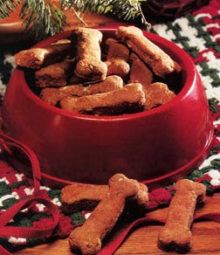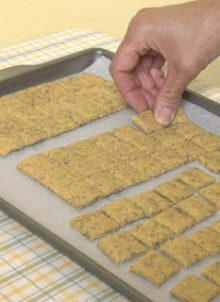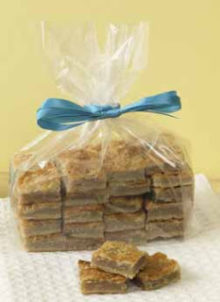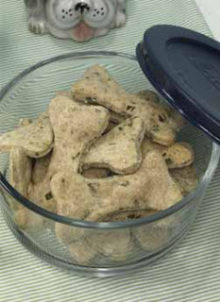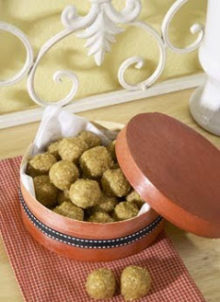Monthly Archives: December 2017
Healthy Dog Treats
- 2 cups whole-wheat flour
- 1/2 cup all-purpose flour
- 1/4 cup cornmeal
- 1/4 cup sunflower kernels, finely chopped
- 1 teaspoon salt
- 1/4 cup molasses
- 2 eggs, beaten
- 1/4 cup milk
- 2 tablespoons vegetable oil
Instructions:
Mix all ingredients, adding more milk if needed to make dough firm. Roll out onto a floured surface to a 1/2-inch thickness. Use any shape cookie cutter to cut out biscuits, but bone shapes are fun!
Bake on ungreased baking sheet at 350 degrees for 30 minutes or until lightly toasted. To make biscuits harder, leave in oven with the heat turned off for an hour or more.
Found at: Free Pet Projects
Chompin’ Chicken Bites
- ½ pound ground chicken
- 2 cups all-purpose flour
- 1 cup cornmeal
- ¾ cup low-sodium chicken broth
- 3 tablespoons vegetable oil
- 1 egg
- 1 tablespoon finely chopped tarragon
Instructions:
Preheat oven to 375 degrees. In a non-stick skillet, cook chicken until done; crumble into small pieces and set aside to cool. In a medium bowl, combine flour and cornmeal. In a small bowl, combine chicken broth, vegetable oil, egg, and tarragon; beat until well combined.
Stir wet ingredients into dry ingredients to form a soft dough. Knead chicken into dough. Working with ½ of the dough at a time, press dough into a rectangle and roll out onto parchment paper to ¼-inch thickness. Using a pizza cutter, cut into 1-inch squares.
Move parchment to a baking sheet and bake 20 to 23 minutes or until firm and dry. Cool on baking sheet; break squares apart. Repeat with remaining dough.
Store in an airtight container in refrigerator up to 1 week or in freezer up to 3 months.
Yield: about 15½ dozen bites
Found at Free Pet Projects
Tuna Melt Squares for Dogs and Cats
- 1 (6 ounce) can tuna, in oil
- ¼ cup cottage cheese
- ¾ cup all-purpose flour
- ¼ cup shredded cheddar cheese
- 2 tablespoons Parmesan cheese
Instructions:
Preheat oven to 350 degrees. In a medium bowl, combine tuna and cottage cheese; beat until smooth, about 2 minutes. Add flour and stir until well combined. (Dough will be sticky.)
Use greased hands to pat dough into a lightly greased 8-inch square pan. Sprinkle cheddar cheese and Parmesan cheese on top. Bake 35 minutes or until edges are golden brown.
Cool and cut into 1-inch squares. Store in an airtight container in refrigerator up to 1 week or in freezer up to 3 months.
Yield: forty-nine 1-inch squares
Found at Free Pet Projects
Minty Fresh Dog Biscuits
- 2 cups all-purpose flour
- 1/2 cup whole wheat flour
- 1/4 cup minced fresh parsley
- 3 tablespoons minced fresh mint
- 3/4 cup water
- 2 tablespoons vegetable oil
- 2 tablespoons honey
Instructions:
Preheat oven to 350 degrees.
In a medium bowl, stir together flours, parsley, and mint. In a small bowl, combine water, vegetable oil, and honey. Add wet ingredients to dry ingredients; mix well to form a soft dough.
Working with 1/2 of the dough at a time, roll out on a lightly floured surface to 1/8-inch thickness. Cut out dough with cookie cutters, using desired shapes.
Transfer to a lightly greased baking sheet and bake 20-25 minutes or until lightly browned. Transfer biscuits to a wire rack to cool. Store in an airtight container in refrigerator up to 2 weeks or in freezer up to 3 months.
Yields:
- 2 dozen small biscuits
- 4 dozen large biscuits
Found at Free Pet Projects
Fetch ’Em Peanut Butter Balls
- 1 cup coarsely crushed rice cereal
- ¼ cup smooth peanut butter
- 1 tablespoon honey or molasses
- 2 tablespoons wheat germ
Instructions:
In a small bowl, combine cereal, peanut butter, and honey or molasses; stir until mixture forms a ball.
Scoop out teaspoonfuls of mixture and roll into 1-inch balls.(Balls can be rolled smaller or larger to suit the size of your dog.) Roll balls in wheat germ to cover.
Store in an airtight container in refrigerator up to 2 weeks.
Yield: sixteen 1-inch balls
Found at Free Pet Projects
Cheesy Thumbprint Cookies For Dogs
- 1 cup whole wheat flour
- 2 tablespoons cornmeal
- 2 tablespoons Parmesan cheese
- 6 tablespoons water
- 2 tablespoons olive oil
- 1 egg
- 3 (1 ounce) mozzarella cheese sticks
Instructions:
Preheat oven to 350 degrees. In a medium bowl, combine wheat flour, cornmeal, and Parmesan cheese. In a small bowl, combine water, olive oil, and egg; beat until well combined. Add wet ingredients to dry ingredients; mix until smooth.
Using a tablespoon, scoop out dough and roll into balls. Place balls onto a lightly greased baking sheet. Using your thumb, press a slight indention into center of each cookie. Cut cheese sticks into 6 pieces and place into centers of cookies.
Bake for 20 minutes or until cookies are lightly browned on bottom. Store cookies in refrigerator for up to 2 weeks or in freezer for up to 3 months.
Yield: about 1-½ dozen cookies
Found at Free Pet Projects
17 Common Plants Poisonous to Dogs
- Amaryllis
Common garden plants popular around Easter, Amaryllis species contain toxins that can cause vomiting, depression, diarrhea, abdominal pain, hypersalivation, anorexia and tremors.
- Autumn Crocus
Ingestion of Colchicum autumnale by pets can result in oral irritation, bloody vomiting, diarrhea, shock, multi-organ damage and bone marrow suppression.
- Azalea/Rhododendron
Members of the Rhododenron spp. contain substances known as grayantoxins, which can produce vomiting, drooling, diarrhea, weakness and depression of the central nervous system in animals. Severe azalea poisoning could ultimately lead to coma and death from cardiovascular collapse.
- Castor Bean
The poisonous principle in Ricinus communis is ricin, a highly toxic protein that can produce severe abdominal pain, drooling, vomiting, diarrhea, excessive thirst, weakness and loss of appetite. Severe cases of poisoning can result in dehydration, muscle twitching, tremors, seizures, coma and death.
- Chrysanthemum
These popular blooms are part of the Compositae family, which contain pyrethrins that may produce gastrointestinal upset, including drooling, vomiting and diarrhea, if eaten. In certain cases depression and loss of coordination may also develop if enough of any part of the plant is consumed.
- Cyclamen
Cylamen species contain cyclamine, but the highest concentration of this toxic component is typically located in the root portion of the plant. If consumed, Cylamen can produce significant gastrointestinal irritation, including intense vomiting. Fatalities have also been reported in some cases.
- English Ivy
Also called branching ivy, glacier ivy, needlepoint ivy, sweetheart ivy and California ivy, Hedera helix contains triterpenoid saponins that, should pets ingest, can result in vomiting, abdominal pain, hypersalivation and diarrhea.
- Kalanchoe
This plant contains components that can produce gastrointestinal irritation, as well as those that are toxic to the heart, and can seriously affect cardiac rhythm and rate.
- Lilies
Members of the Lilium spp. are considered to be highly toxic to cats. While the poisonous component has not yet been identified, it is clear that with even ingestion of very small amounts of the plant, severe kidney damage could result.
- Marijuana
Ingestion of Cannabis sativa by companion animals can result in depression of the central nervous system and incoordination, as well as vomiting, diarrhea, drooling, increased heart rate, and even seizures and coma.
- Oleander
All parts of Nerium oleander are considered to be toxic, as they contain cardiac glycosides that have the potential to cause serious effects—including gastrointestinal tract irritation, abnormal heart function, hypothermia and even death.
- Peace Lily (AKA Mauna Loa Peace Lily)
Spathiphyllum contains calcium oxalate crystals that can cause oral irritation, excessive drooling, vomiting, difficulty in swallowing and intense burning and irritation of the mouth, lips and tongue in pets who ingest.
- Pothos
Pothos (both Scindapsus and Epipremnum) belongs to the Araceae family. If chewed or ingested, this popular household plant can cause significant mechanical irritation and swelling of the oral tissues and other parts of the gastrointestinal tract.
- Sago Palm
All parts of Cycas Revoluta are poisonous, but the seeds or “nuts” contain the largest amount of toxin. The ingestion of just one or two seeds can result in very serious effects, which include vomiting, diarrhea, depression, seizures and liver failure.
- Schefflera
Schefflera and Brassaia actinophylla contain calcium oxalate crystals that can cause oral irritation, excessive drooling, vomiting, difficulty in swallowing and intense burning and irritation of the mouth, lips and tongue in pets who ingest.
- Tulip/Narcissus bulbs
The bulb portions of Tulipa/Narcissus spp. contain toxins that can cause intense gastrointestinal irritation, drooling, loss of appetite, depression of the central nervous system, convulsions and cardiac abnormalities.
- Yew
Taxus spp. contains a toxic component known as taxine, which causes central nervous system effects such as trembling, incoordination, and difficulty breathing. It can also cause significant gastrointestinal irritation and cardiac failure, which can result in death.
More Info:
For a more definitive list, complete with pictures, visit the ASPCA Toxic and Non-Toxic Plants List.
This list contains plants that have been reported as having systemic effects on animals and/or intense effects on the gastrointestinal tract.
Please note that the information contained in our plant lists is not meant to be all-inclusive, but rather a compilation of the most frequently encountered plants. If you think that your animal is ill or may have ingested a poisonous substance, contact your local veterinarian or our 24-hour emergency poison hotline directly at 1-888-426-4435.
Spotlight On Bichons
A cheerful, happy dog, the Bichon Frise is small and sturdy with a dark-eyed inquisitive expression and a plumed tail it carries merrily over the back. The breed is often compared to a cotton ball due to its curled double coat, which consists of a textured outer coat and a silky undercoat. The coat must be white, but may have shadings of buff, cream or apricot around the ears or on the body.
- General Appearance
The Bichon Frise is a small, sturdy, white powder puff of a dog whose merry temperament is evidenced by his plumed tail carried jauntily over the back and his dark-eyed inquisitive expression.
- A Look Back
The Bichon Frise appeared in the 13th century as a descendent from the Water Spaniel. Because of their merry disposition, they traveled much and were often used as items of barter by sailors as they moved from continent to continent. The dogs found early success in Spain and it is generally felt that Spanish seamen introduced the breed to the Canary Island of Teneriffe. In the 1300s Italian sailors rediscovered the little dogs on their voyages and are credited with returning them to the Continent, where they became great favorites of Italian nobility. Often, as was the style of the day with dogs in the courts, they were cut “lion style.”
The “Teneriffe” or “Bichon” had success in France during the Renaissance under Francis I (1515-47) but its popularity skyrocketed in the court of Henry III (1574-89). The breed also enjoyed considerable success in Spain as a favorite of the Infantas, and painters of the Spanish school often included them in their works. For example, the famous artist, Goya, included a Bichon in several of his works.
Interest in the breed was renewed during the rule of Napoleon III, but then waned until the late 1800s when it became the “common dog”, running the streets, accompanying the organ grinders of Barbary, leading the blind and doing tricks in circuses and fairs. Although the breed’s colorful past includes use as a circus dog, today the Bichon is enjoyed primarily as a companion animal.
On March 5, 1933 the official standard of the breed was adopted by the Societe Centrale Canine of France. As the breed was known by two names at that time, “Teneriffe” and “Bichon”, the president of the International Canine Federation proposed a name based on the characteristics that the dogs presented – the Bichon Frise. (“Frise” refers to the dog’s soft, curly hair.) On October 18, 1934 the Bichon Frise was admitted to the stud book of the French Kennel Club.
- Right Breed for You?
The Bichon is a naturally gentle, playful dog. He loves activity and requires regular exercise. His hair grows continually and does not shed, so extensive grooming is a must to prevent mats. Bichons also tend to be a good breed for allergy sufferers.
- Temperament
Gentle mannered, sensitive, playful and affectionate. A cheerful attitude is the hallmark of the breed and one should settle for nothing less.
If you are considering purchasing a Bichon Frise puppy, learn more here.
Source: The American Kennel Club, Inc.
